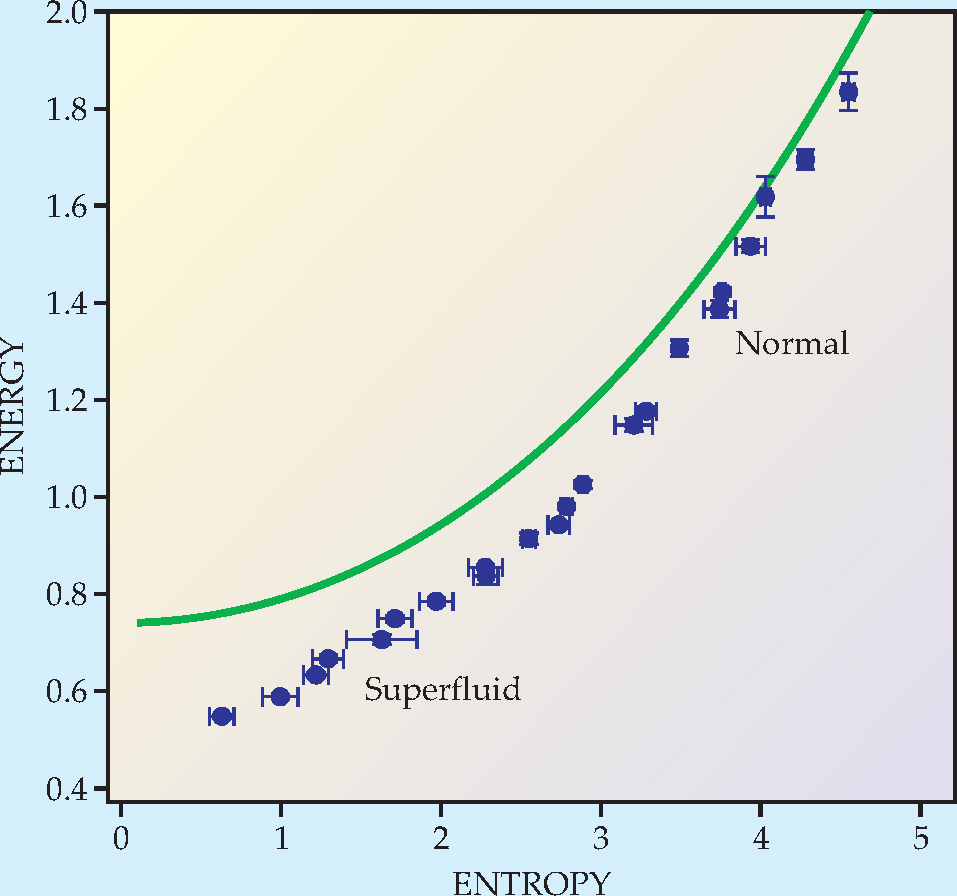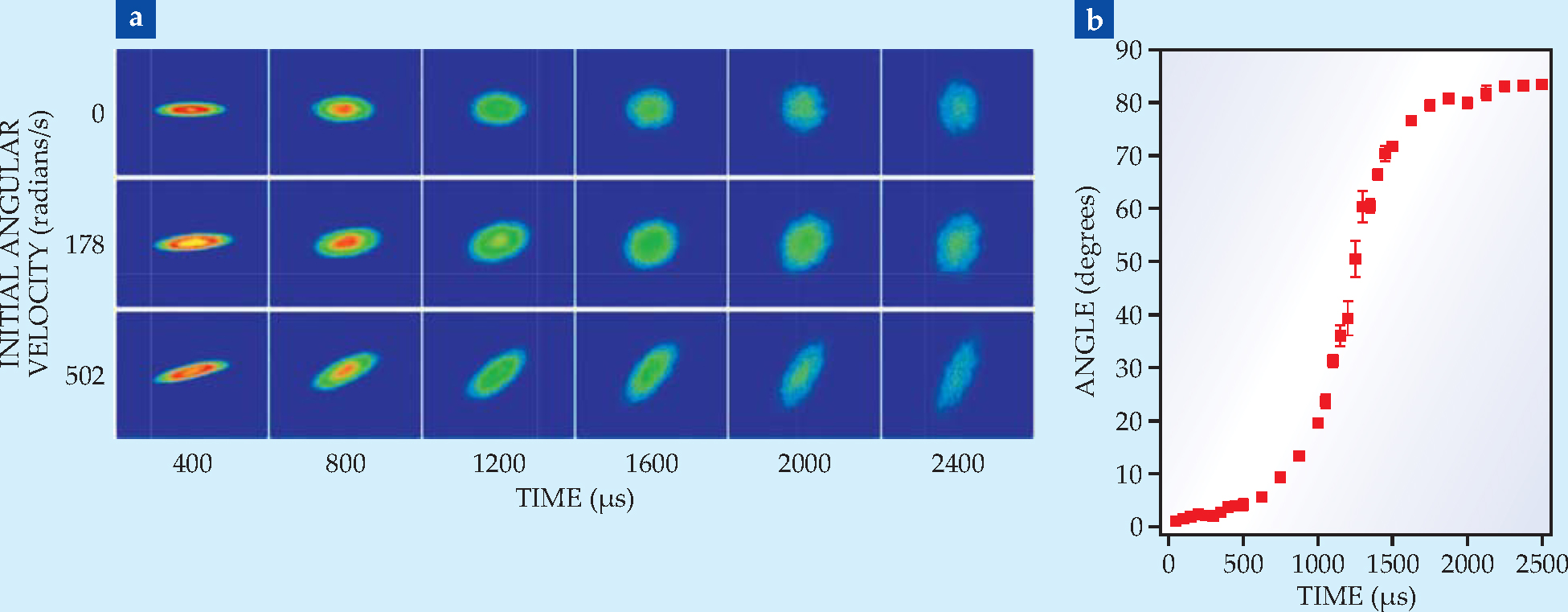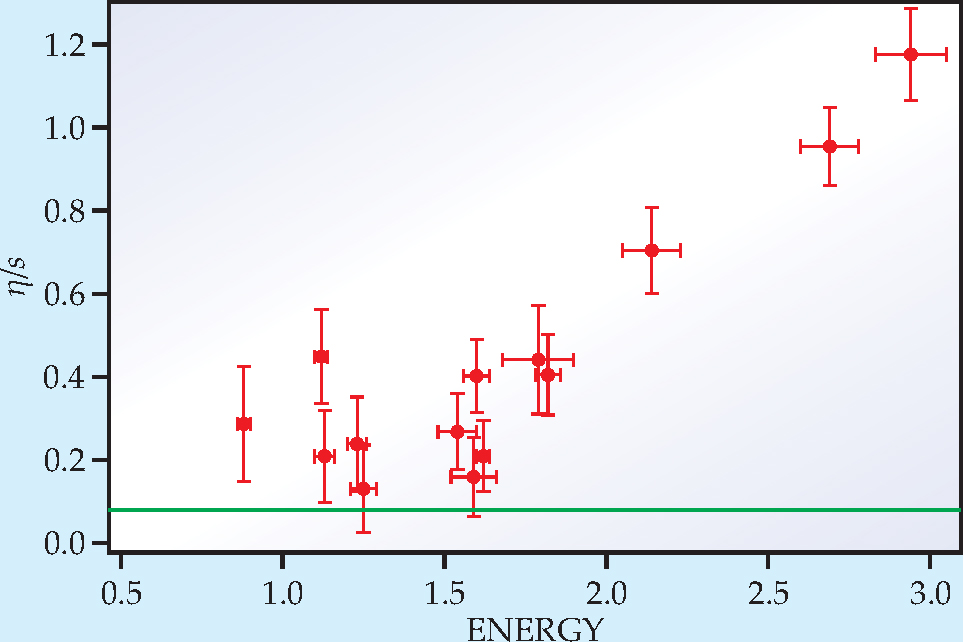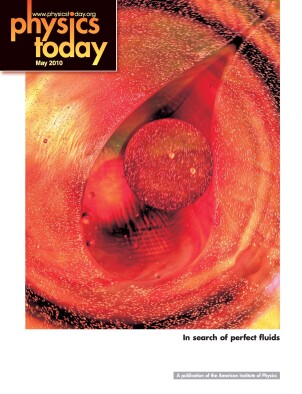The nearly perfect Fermi gas
DOI: 10.1063/1.3431329
It is hard to imagine that the most strongly interacting nonrelativistic system known is a quantum degenerate atomic Fermi gas comprising just a few hundred thousand spin-up and spin-down atoms in an optical trap. An external magnetic field controls the strength of the scattering between spin-up and spin-down atoms, which interact very strongly when the field is correctly tuned. Evaporative cooling in the optical trap efficiently brings the temperature down to the quantum degenerate regime, where the atomic momentum is so small that the de Broglie wavelength is comparable to the interatomic spacing and quantum statistics is important. Quantum degenerate, strongly interacting Fermi gases, first produced 1 in 2002, are now widely studied. 2 They provide model systems for tabletop studies of high-temperature superconductivity, neutron stars, and nuclear matter.
Remarkably, those supercold Fermi gases share a feature with an exotic soup of quarks and gluons, a quark-gluon plasma (QGP), that existed just microseconds after the Big Bang. Heavy ion collisions at Brookhaven National Laboratory’s Relativistic Heavy Ion Collider have produced a strongly interacting QGP that is 19 orders of magnitude hotter and 25 orders of magnitude denser than the Fermi gases (see and the article by Barbara Jacak and Peter Steinberg on

Figure 1. Upon release from a cigar-shaped trap, a cloud of strongly interacting lithium-6 atoms experiences a pressure gradient that is larger in the transverse directions than in the longitudinal direction. As a result, it expands and changes in shape from cigar to ellipse. Such elliptic flow arises in a quark-gluon plasma as well, and it is a consequence of very low viscosity hydrodynamics characteristic of a nearly perfect fluid. The color scale indicates density, with red more dense and light blue less dense. Time increases from 0.1 ms after release (top image) to 2 ms (bottom image).
(Adapted from ref. 1.)

Universal behavior and perfect fluidity
A pair of colliding spin-up and spin-down atoms interacts most strongly when its total energy is near that of a so-called Feshbach resonance (see the Reference Frame by Daniel Kleppner in Physics Today, August 2004, page 12
In particular, a strongly interacting gas in the universal regime is scale invariant; its properties are determined by the density n and the temperature T, the same variables that determine the properties of a noninteracting ideal gas. The ground-state energy of a strongly interacting Fermi gas differs from that of a noninteracting one at the same density by a universal factor whose precisely calculated value is in close agreement with measurements from experiments worldwide. 2,4
The normal, nonsuperfluid strongly interacting Fermi gas is of great interest because it might be a perfect fluid—one having the minimum value allowed by quantum mechanics for the ratio of shear viscosity to entropy density, η/s. Superfluids have very small viscosity, but η/s actually increases below the normal-to-superfluid transition temperature.
Dimensional analysis suggests a quantum viscosity scale with the appropriate units of momentum/area. A natural momentum scale is ħ/L, where ħ is Planck’s constant and L is the interparticle spacing, which also determines a natural area L
2
. Thus the shear viscosity can be expressed as
In 2005 Pavel Kovtun and colleagues applied string theory methods to relate a class of strongly interacting systems to “dual” weakly interacting systems (for additional detail, see the article by Clifford Johnson and Peter Steinberg on
Measuring entropy and energy
The temperature of a trapped gas is spatially constant, but the density varies. Thus
In part to characterize the entropy and viscosity of a normal strongly interacting Fermi gas, Le Luo, Bason Clancy, and I measured the entropy and the energy of a gas of 6Li atoms throughout the superfluid and normal fluid regimes. 4 Figure 2 shows a shift in the scaling of energy with entropy that signals a corresponding change in thermodynamic properties. The energy at which the scaling change occurs delimits the transition from superfluid to normal fluid. Entropy and viscosity measurements above that energy thus characterize normal fluid behavior.

Figure 2. The superfluid-to-normal-fluid transition for lithium-6, a strongly interacting Fermi gas, is signaled by a change in the scaling of energy with entropy. On this plot, the energy per particle is divided by the Fermi energy of an ideal Fermi gas at the trap center, and the entropy per particle is divided by Boltzmann’s constant. The data indicate that the transition takes place at a normalized energy of about 0.8. For comparison, the green curve shows the energy-entropy plot for an ideal Fermi gas.
(Adapted from ref. 4.)

A remarkable feature of strongly interacting Fermi gases in the universal regime is that the energy and entropy can be determined by simple measurements of trapped cloud sizes. Energy measurements are based on the virial theorem. At low temperatures, the optical trap that confines the atoms provides a nearly harmonic potential. Then the total energy

Figure 3. The mean-square size of a trapped Fermi gas determines its energy and entropy. When the particles are strongly interacting, as in the left image, measurements of the cloud size yield the total energy. By slowly sweeping an external magnetic field, an experimenter can adiabatically shunt the system to a weakly interacting regime. In that case (right image) it is the entropy that is revealed by the mean-square size of the cloud. The interactions in the strong regime are attractive; not surprisingly, the corresponding cloud is the smaller of the two. Both clouds are roughly 200 µm across; red indicates regions of greater density.

The effective spring constant,
The conceptual simplicity of the energy measurement is, as earlier noted, a consequence of universal behavior. The gas generally contains condensed superfluid pairs, noncondensed pairs, and unpaired atoms, all strongly interacting; nonetheless, the mean-square size of the trapped cloud determines the total energy.
The key to measuring the average entropy S is to use an adiabatic sweep of a magnetic field to tune the system from the strongly interacting regime near the Feshbach resonance to a weakly interacting regime far from resonance. In that weak regime, the entropy S W of the cloud is nearly that of an ideal Fermi gas in a harmonic trap, which can be calculated by elementary methods from the density of states and the entropy per state of an ideal gas at temperature T. The corresponding mean-square size of a weakly interacting Fermi gas 〈z 2〉W is both calculable and measurable. The calculation establishes the link between the observable 〈z 2〉W and the entropy S W.
In our experiment, Luo, Clancy, and I had to verify that the magnetic-field sweep was adiabatic and, therefore, that the determined entropy S W is the same as that in the strongly interacting regime. To do that, we performed a roundtrip sweep. Since, within experimental error, the energy after the roundtrip was the same as before the sweep, it follows that the sweep did not change the entropy.
As noted in the caption of figure 2, an observed change in the scaling of energy with entropy indicates the transition from superfluid to normal fluid. Fitting a smooth curve to the data, and using
Estimating shear viscosity
Briefly releasing a strongly interacting Fermi gas from an optical trap and then recapturing it excites a “breathing mode” hydrodynamic oscillation in the cloud size. By measuring the damping time of those oscillations, one can estimate the gas’s shear viscosity and compare it with theoretical predictions. My colleagues and I combined estimates of the shear viscosity from damping measurements with entropy data to get the η/s ratio for 6Li. Our value
8
was comparable to that of liquid He near the λ point—significantly higher than the string-theory bound in equation
To investigate low-viscosity hydrodynamics in a trap-free environment, Clancy, Luo, and I studied the free-expansion dynamics of 6Li atoms released from a rotating optical trap. 9 We evaporatively cooled the gas to near its ground state and added a controlled amount of energy. Once the gas was released from the trap, we imaged its rotation over time; figure 4 shows typical data for a few initial angular velocities. As the gas expands, the angular velocity increases. That behavior is a consequence of the very low viscosity hydrodynamics and elliptic flow: As the cloud changes from cigar-shaped to more spherical, the moment of inertia decreases.

Figure 4. A rotating, strongly interacting Fermi gas speeds up as it expands. (a) In these images of lithium-6, time increases from left to right, and initial angular velocity increases from top to bottom. Red indicates regions of higher density; blue regions have lower density. (b) The angular displacement versus time for the cloud whose initial angular speed was 178 rad/s. The large angular acceleration observed as the cloud expands indicates that the Fermi gas has a very low viscosity.
(Adapted from ref. 9.)

To estimate the viscosity, we began with an exact solution to the hydrodynamic equations absent viscosity and assumed that viscosity causes the observed slowing down relative to the zero-viscosity solution. After adding terms to the hydrodynamic equations that arise from shear viscosity, we found that the predicted slowing depends on the trap-averaged viscosity parameter, 〈α〉. The empirical data indicate that 〈α〉 increases as the initial energy of the trapped cloud is increased.
Combining the viscosity estimates from the rotating-trap experiment with the entropy measurements described earlier yields the η/s ratios shown in figure 5, which also indicates how close the measured ratios come to the conjectured lower bound. Our results suggest that a strongly interacting Fermi gas in the normal fluid regime may be a nearly perfect fluid.

Figure 5. The experimentally determined ratio of shear viscosity to entropy density (η/s, red data points) for normal, strongly interacting lithium-6 is comparable to the conjectured lower bound inspired by string theory (green line).

Currently, my colleagues and I are developing model-independent methods for measuring shear viscosity. Combined with our model-independent measurements of the thermodynamic properties, viscosity data could offer new challenges for those doing state-of-the-art nonperturbative many-body calculations. Perhaps studies of strongly interacting gases will spur new developments in the application of string-theory methods to those fascinating systems; if so, we can look forward to a richer understanding of the deep connections between strongly and weakly interacting systems.
References
1. K. M. O’Hara et al., Science 298, 2179 (2002). https://doi.org/10.1126/science.1079107
2. I. Bloch, J. Dalibard, W. Zwerger, Rev. Mod. Phys. 80, 885 (2008);
S. Giorgini, L. P. Pitaevskii, S. Stringari, Rev. Mod. Phys. 80, 1215 (2008); https://doi.org/10.1103/RevModPhys.80.1215
W. Ketterle, M. Zwierlein, in Ultra-cold Fermi Gases: Proceedings of the International School of Physics “Enrico Fermi,” Course CLXIV, M. Inguscio, W. Ketterle, C. Salomon, eds., IOS Press, Amsterdam (2008) p. 95
.3. P. F. Kolb, U. Heinz, in Quark–Gluon Plasma 3, R. C. Hwa, X.-N. Wang, eds., World Scientific, River Edge, NJ (2004), p. 634;
B. A. Gelman, E. V. Shuryak, I. Zahed, Phys. Rev. A 72, 043601 (2005). https://doi.org/10.1103/PhysRevA.72.0436014. L. Luo J. E. Thomas, J. Low Temp. Phys. 154, 1 (2009). https://doi.org/10.1007/s10909-008-9850-2
5. G. M. Bruun H. Smith, Phys. Rev. A 75, 043612 (2007). https://doi.org/10.1103/PhysRevA.75.043612
6. P. K. Kovtun, D. T. Son, A. O. Starinets, Phys. Rev. Lett. 94, 111601 (2005). https://doi.org/10.1103/PhysRevLett.94.111601
7. G. Rupak T. Scha¨fer, Phys. Rev. A 76, 053607 (2007). https://doi.org/10.1103/PhysRevA.76.053607
8. A. Turlapov et al., J. Low Temp. Phys. 150, 567 (2008). https://doi.org/10.1007/s10909-007-9589-1
9. B. Clancy, L. Luo, J. E. Thomas, Phys. Rev. Lett. 99, 140401 (2007). https://doi.org/10.1103/PhysRevLett.99.140401
More about the Authors
John Thomas is the Fritz London Distinguished Professor of Physics at Duke University in Durham, North Carolina.
John E. Thomas. Duke University, Durham, North Carolina, US .
